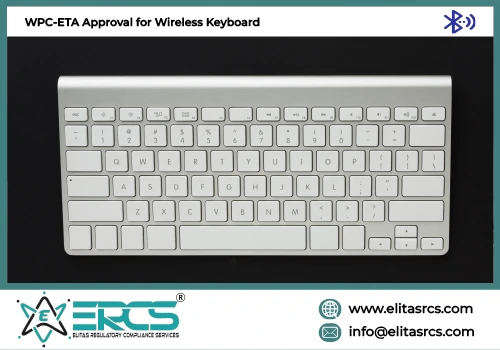WPC Approval (ETA) for
Wireless Keyboard

WIRELESS KEYBOARD
A Wireless Keyboard is a computer input device that doesn't need to be hardwired into a device. Instead of wired connections, it communicates with a computer using Bluetooth or RF (radio frequency).
Wireless keyboards are helpful since they eliminate the requirement that you keep your hands on the computer's keyboard at all times. This makes them ideal for use in presentations, media centres, and other situations when you need to manage your computer from a distance, or even in a different room.
The keyboard interacts with your computer using a little USB receiver. Some of the newest versions have Bluetooth connectivity, making them compatible with more modern gadgets like smartphones and tablets.
Wireless keyboards provide the benefit of portability, allowing you to switch from one computer to another with no effort. Also, they may be adjusted to fit the user's physique more naturally, making them more comfortable. Not only that, but they help you declutter your desk by doing away with all the cables and cords.
There are, however, drawbacks to using a wireless keyboard. Batteries are needed and should be swapped out regularly. Problems with latency and connection may also be caused by other wireless devices and even physical obstructions. Lastly, the wireless options usually cost more than their wired equivalents.
Wireless keyboards, in general, are an ergonomic and fuss-free method to type without being chained to your computer. Although wireless keyboards have many advantages, users should be aware of the technology's limits and choose one that works best for them.
Due to the lack of wireless charging, wireless keyboards do not normally need WPC (Wireless Power Consortium) certification. They may, however, be subject to further Bluetooth or RF wireless communication standards (radio frequency).
In order to work with other Bluetooth devices, a Bluetooth keyboard, for instance, must adhere to a set of standards and requirements established by the Bluetooth Special Interest Group (SIG). In order to utilise the Bluetooth trademark and guarantee that their goods are up to snuff, manufacturers must first receive Bluetooth certification from the SIG.
Equally, the FCC has rules that wireless keyboards must follow to avoid disrupting other electronics and radio frequencies.
To guarantee compatibility with certain devices or operating systems, some manufacturers choose to get certifications or standards such as Microsoft's Hardware Certification or Apple's MFi (Made for iPhone/iPad) programme.
While wireless keyboards don't need WPC certification, they still need to meet other safety and reliability criteria. To make sure their wireless keyboards are up to par and compatible with their devices, shoppers can seek for certifications and logos like Bluetooth certification.
Basic Requirement to get WPC (ETA) approval
Following requirement should be fulfilled by applicant –
Foreign Manufacturers –
Foreign Manufacturer (Applicant) has to appoint Authorized Indian Representative (AIR).
If Foreign Manufacture (applicant) has the Branch office/Liaison office in India then, they can become an AIR.
Domestic Manufacturer –
The domestic (Indian) Manufacturer can directly apply for ETA and import license without nomination of AIR.
Required Documents
For ETA Certificate –
- Copy of Company Registration /GST registration (For address Verification)
- ID and address proof of authorized person
- Radio Frequency (RF) Test report from any foreign laboratory that is ISO 17025 certified or an Indian laboratory that is NABL approved
- Authorization letter (If authorized person is other than CEO)
- Product technical details
For Import License –
- ETA Certificate
- Purchase order
- IEC Certificate
- Proforma Invoice
What is RF (Radio frequency) test report and how to get it?
RF (Radio Frequency) testing is a method of checking the frequency of radio transmissions to ensure that they are efficiently using the spectrum. In order to achieve maximum efficiency, it is essential to ensure that radio waves in the airspace do not conflict with one another.
Manufacturers/ Importer need to get the RF test report from the ILAC/NABL accredited lab for ETA approval to sell the product in India. If the multiple RF modules contains in the particular product, then the test report of all modules to uploaded to get ETA approval.
Process to get Equipment type approval (ETA) from WPC department:
- Checking EN standard and RF testing from AuthorizedLaboratory
- Documents Preparation
- Application Filing to WPC (Online portal generation)
- Submitting the requisite fee online to Govt.
- Application Scrutinization by WPC
- Grant of ETA Certificate by WPC

